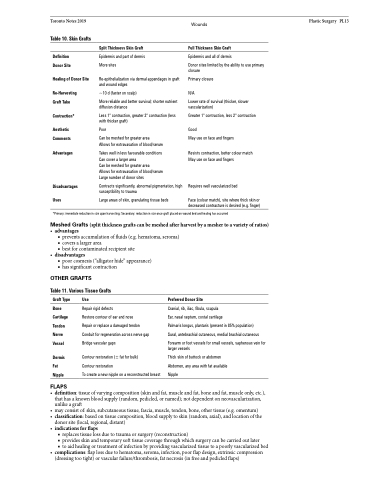Page 1135 - TNFlipTest
P. 1135
Toronto Notes 2019
Wounds
Plastic Surgery PL13
Table 10. Skin Grafts
Definition Donor Site
Healing of Donor Site
Re-Harvesting Graft Take
Contraction*
Aesthetic Comments
Advantages
Disadvantages Uses
Split Thickness Skin Graft
Epidermis and part of dermis More sites
Re-epithelialization via dermal appendages in graft and wound edges
~10 d (faster on scalp)
More reliable and better survival; shorter nutrient diffusion distance
Less 1° contraction, greater 2° contraction (less with thicker graft)
Poor
Can be meshed for greater area
Allows for extravasation of blood/serum
Takes well in less favourable conditions Can cover a larger area
Can be meshed for greater area
Allows for extravasation of blood/serum Large number of donor sites
Contracts significantly, abnormal pigmentation, high susceptibility to trauma
Large areas of skin, granulating tissue beds
Full Thickness Skin Graft
Epidermis and all of dermis
Donor sites limited by the ability to use primary closure
Primary closure
N/A
Lower rate of survival (thicker, slower vascularization)
Greater 1° contraction, less 2° contraction
Good
May use on face and fingers
Resists contraction, better colour match May use on face and fingers
Requires well vascularized bed
Face (colour match), site where thick skin or decreased contracture is desired (e.g. finger)
*Primary: immediate reduction in size upon harvesting; Secondary: reduction in size once graft placed on wound bed and healing has occurred
Meshed Grafts (split thickness grafts can be meshed after harvest by a mesher to a variety of ratios) • advantages
■ prevents accumulation of fluids (e.g. hematoma, seroma) ■ covers a larger area
■ best for contaminated recipient site
• disadvantages
■ poor cosmesis (“alligator hide” appearance) ■ has significant contraction
OTHER GRAFTS
Table 11. Various Tissue Grafts
Graft Type
Bone Cartilage Tendon Nerve Vessel
Dermis Fat Nipple
FLAPS
Use
Repair rigid defects
Restore contour of ear and nose
Repair or replace a damaged tendon Conduit for regeneration across nerve gap Bridge vascular gaps
Contour restoration (± fat for bulk)
Contour restoration
To create a new nipple on a reconstructed breast
Preferred Donor Site
Cranial, rib, iliac, fibula, scapula
Ear, nasal septum, costal cartilage
Palmaris longus, plantaris (present in 85% population)
Sural, antebrachial cutaneous, medial brachial cutaneous
Forearm or foot vessels for small vessels, saphenous vein for larger vessels
Thick skin of buttock or abdomen Abdomen, any area with fat available Nipple
• definition:tissueofvaryingcomposition(skinandfat,muscleandfat,boneandfat,muscleonly,etc.), that has a known blood supply (random, pedicled, or named); not dependent on neovascularization, unlike a graft
• mayconsistof:skin,subcutaneoustissue,fascia,muscle,tendon,bone,othertissue(e.g.omentum)
• classification:basedontissuecomposition,bloodsupplytoskin(random,axial),andlocationofthe
donor site (local, regional, distant)
• indicationsforflaps
■ replaces tissue loss due to trauma or surgery (reconstruction)
■ provides skin and temporary soft tissue coverage through which surgery can be carried out later
■ to aid healing or treatment of infection by providing vascularized tissue to a poorly vascularized bed
• complications:flaplossduetohematoma,seroma,infection,poorflapdesign,extrinsiccompression (dressing too tight) or vascular failure/thrombosis, fat necrosis (in free and pedicled flaps)


